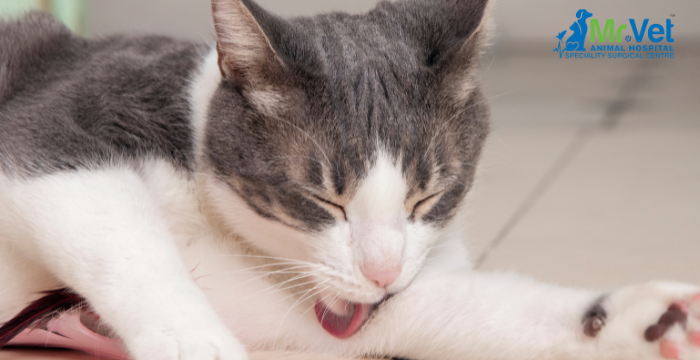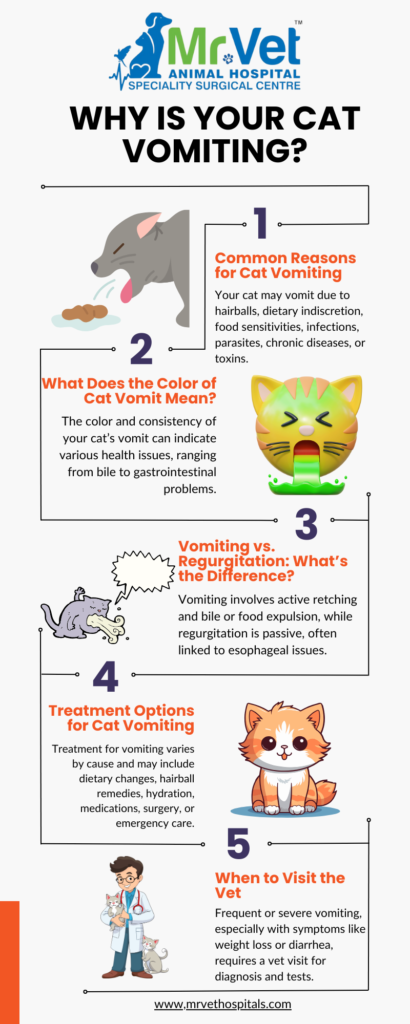
Cats are known for their finicky behavior, but when your feline friend starts vomiting, it can be worrying. Vomiting can indicate several health issues, ranging from harmless to serious. In this blog, we’ll help you understand why your cat might be vomiting, the differences between vomiting and regurgitation, and what the color of vomit can tell you. We’ll also explore treatment options to keep your pet healthy.
Common Reasons for Cat Vomiting
There are various reasons why your cat might be vomiting, including:
- Hairballs: Cats often groom themselves, ingesting fur that forms hairballs. When the hairball gets too large, your cat will vomit it out. While common, frequent hairball vomiting should be monitored.
- Dietary Indiscretion: Cats sometimes eat things they shouldn’t, like spoiled food, plants, or foreign objects. This can lead to stomach irritation, causing vomiting.
- Food Sensitivities or Allergies: Some cats are sensitive to certain ingredients in their food, leading to digestive upset and vomiting. Switching to hypoallergenic or specialized diets can help.
- Infections: Viral or bacterial infections, such as feline panleukopenia or gastrointestinal infections, can lead to vomiting in cats.
- Parasites: Intestinal parasites, like worms, can cause vomiting, especially if left untreated.
- Chronic Diseases: Conditions such as kidney disease, liver problems, and hyperthyroidism can all lead to vomiting.
- Toxins: Ingesting toxic substances, including household cleaners, plants, or human medications, can result in vomiting and may require immediate medical attention.
What Does the Color of Cat Vomit Mean?
The color and consistency of your cat’s vomit can provide important clues about their health. Here’s what you should know:
- Clear or White Foam: This may indicate that your cat has an empty stomach and is vomiting bile. It could be due to hunger or a mild stomach upset.
- Yellow or Green Vomit: This is usually bile, a digestive fluid. It can signal an empty stomach, but if it happens frequently, it could indicate a liver or gallbladder issue.
- Brown Vomit: Brown vomit may indicate that your cat is vomiting partially digested food, which could suggest a gastrointestinal problem. If the vomit looks like coffee grounds, it could be a sign of internal bleeding.
- Red or Bloody Vomit: Blood in vomit is always a concern. It could be due to stomach ulcers, tumors, or trauma, and requires immediate veterinary attention.
- Undigested Food: If your cat vomits right after eating, the food may be undigested. This could suggest food intolerance or a condition like gastritis.
Vomiting vs. Regurgitation: What’s the Difference?
It’s important to differentiate between vomiting and regurgitation as they have different causes and treatments.
- Vomiting: Involves active retching and heaving, where your cat’s abdominal muscles contract to expel contents from the stomach. Vomiting may include bile, partially digested food, and can be accompanied by signs of nausea such as drooling or lip-smacking.
- Regurgitation: This is a passive process where food is expelled without the abdominal effort seen in vomiting. It usually occurs soon after eating and the food will appear undigested. Regurgitation is often linked to esophageal issues.
Treatment Options for Cat Vomiting
Treatment for vomiting depends on the underlying cause. Here are some common treatments:
- Dietary Adjustments: If food intolerance is suspected, switching to a hypoallergenic or sensitive-stomach formula may reduce vomiting. Gradual changes are key to prevent digestive upset.
- Hairball Remedies: Regular grooming and hairball control diets can help reduce hairball-related vomiting. Specialized hairball lubricants or treats can also help your cat pass hairballs naturally.
- Hydration: Frequent vomiting can lead to dehydration. Ensure your cat has access to fresh water, and your vet may recommend fluids if dehydration is a concern.
- Medications: In some cases, your vet may prescribe anti-nausea medications, antibiotics for infections, or antiparasitic treatments if worms are detected.
- Surgical Intervention: If vomiting is caused by a foreign object or a more severe condition like tumors, surgical treatment may be necessary.
- Emergency Care: If vomiting is accompanied by symptoms such as lethargy, diarrhea, or signs of pain, seek immediate veterinary care. Bloody vomit, prolonged vomiting, or exposure to toxins also require urgent attention.
When to Visit the Vet
Occasional vomiting may not be a cause for alarm, but frequent or severe vomiting warrants a visit to the vet. Watch for other symptoms such as weight loss, changes in appetite, or diarrhea, as these could indicate a more serious condition. Your vet will conduct a thorough examination, and may run blood tests, ultrasounds, or X-rays to determine the cause of the vomiting.
Conclusion
Understanding the reasons behind your cat’s vomiting, the importance of vomit color, and the difference between vomiting and regurgitation can help you take better care of your pet. If your cat is vomiting frequently or showing signs of distress, it’s essential to consult with a veterinarian to ensure your cat receives the right treatment.
At MrVet Hospitals, our team of experienced veterinarians is here to provide the best care for your pet. Whether it’s diagnosing the cause of vomiting or offering personalized treatment plans, we’re dedicated to keeping your feline friend healthy and happy.


